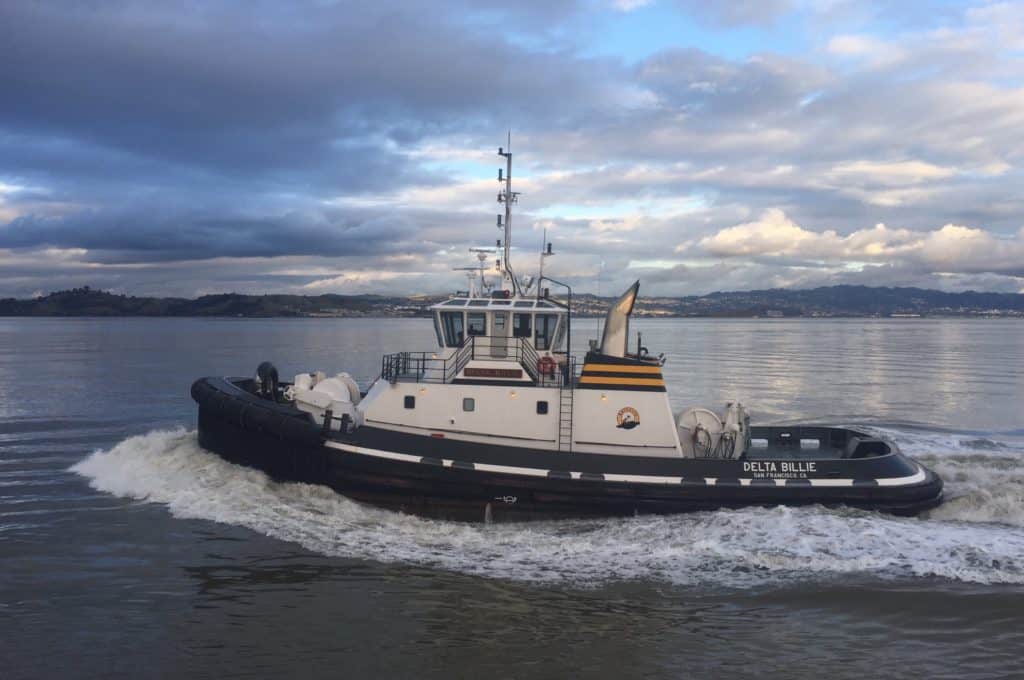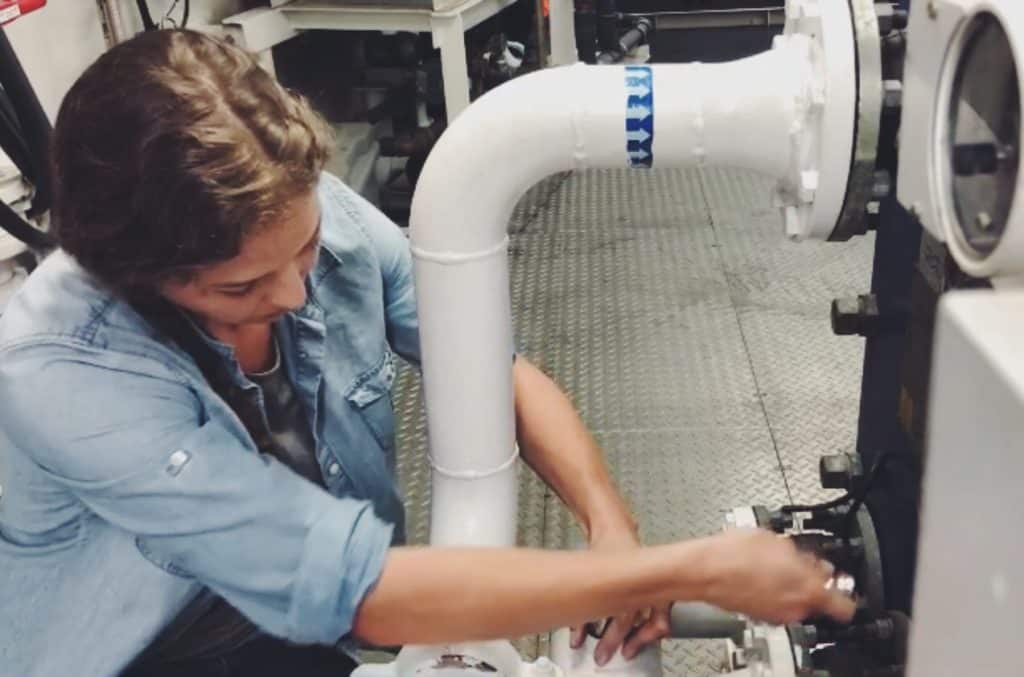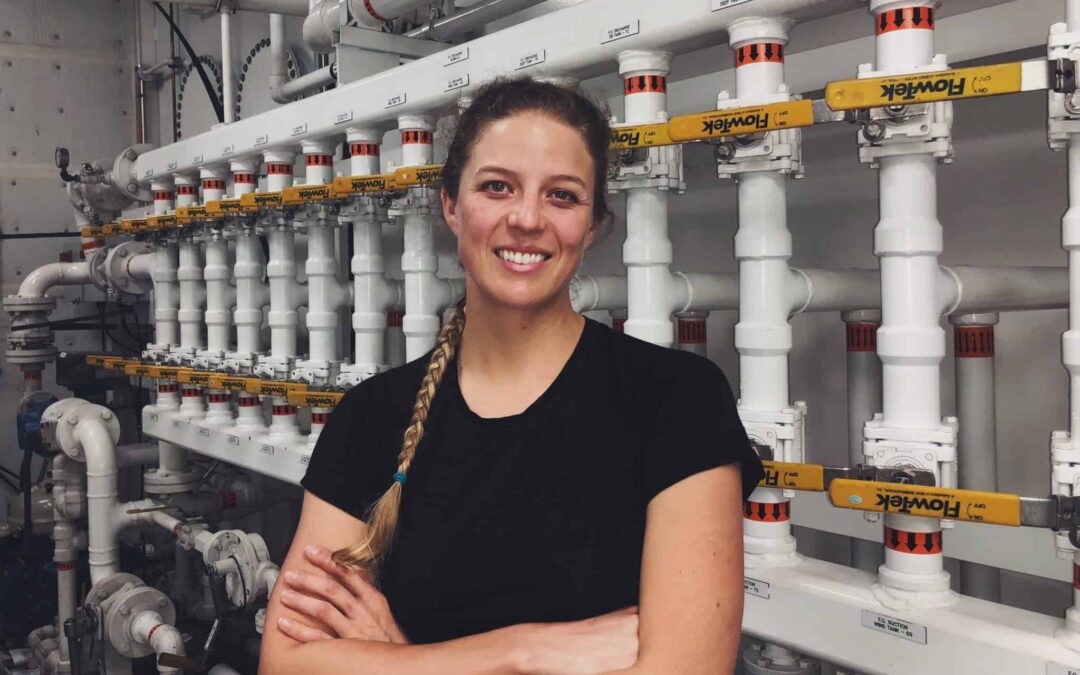One month ago, I was driving home from the airport. I had flown into San Francisco from Seattle and was headed home through Sonoma County to my mom’s house in Napa, where I would get my things together before going to work that night. I was sitting there in the afternoon traffic in Carneros when I began thinking about what was to come: I was going to crew up on the boat at 2100 that night as the engineer – the “chief.”
At my company, anyone who aspires to become a captain, also known as an operator, is required to spend time in the position of deck hand and engineer before they are allowed to begin training as an operator. I had gotten signed off in the engine room at last and this week I would be in charge of the engine room, responsible for transferring fuel and maintaining the engines, generators, drives, winches and all of their systems.
The next moment, a wave of fear and nausea washed over me. I can’t do it. I can’t do this, I’m going to fail. The fear was so overwhelming, I found myself crying. I was all alone, in traffic on a warm spring afternoon, and the fear of failure loomed dark and menacing in front of me. The first time I worked on a tugboat and saw the fuel manifold, bristling with valves, in the engine room, I thought to myself, “Oh, heck no.” I could never figure that out! How do those guys do it? It must be impossible, it must be so confusing. For me, it all seemed to happen inside a black box. I had no idea how things worked.

Slowly but surely, I learned the systems as I made engine rounds and completed sea projects over those first few years. Later, during a stint as a “deckineer” in Tacoma, I became more familiar with start-stop procedures and transferring between shore and generator power. Working as a chief mate in Valdez, I participated as often as I could in oil and fuel filter changes, as well as various other projects with the engineers who were interested in helping me learn. (The guys who taught me on all of the boats I worked on over the years were some of the best humans I’ve ever met – shout out to you all, I’m eternally grateful.)
And a month ago, as I sat there telling myself I couldn’t possibly sail as chief, I had already been working as a deck hand for a year and a half and learning just about everything I could learn about our engine rooms. I certainly didn’t know everything – I was not trained as a QMED or a mechanic – but I was ready to confidently complete the basics. If there was anything I didn’t know or was unsure about, our port engineer and operations manager would be a phone call away – they had made this perfectly clear.
So, why was I so terrified? I don’t want to belabor the subject, but I do attribute some of my fears to basic gender biases. Studies show that men will take on a job when they possess 60% percent of the required qualifications, while women won’t take on that job unless they feel they meet 100% of the qualifications. Who is 100% qualified for anything? Pretty much no one that I’ve ever met. Becoming an expert in any field takes years of on-the-job learning. You have to actually do the job to learn it. Luckily, that’s how I operate as well: Throw me into the fire and I will learn, quickly. It might not be pleasant, but it will be a galvanizing experience every time.
To generalize, boys are given toy trucks and tools to play with; girls are given dolls and kitchens and dollhouses; boys are encouraged to go outside, crash around and get dirty; girls are encouraged to play “house” and pressured to be as perfect as possible (leaving little room for imperfection); boys are prized for resourcefulness and mechanical skill; girls are prized for being pretty. Early on, we keep girls away from machines, engineering, science and mathematics, subconsciously teaching them that mechanical things come more naturally to boys, and that care taking, housekeeping, and other soft skills come more naturally to girls. Maybe they do, to some extent. Boys and girls can certainly be different in many ways, but I firmly believe that they should be allowed to take advantage of the exact same opportunities. How anyone can argue to the contrary is beyond me.
So there I sat, my heart and mind racing, crawling along through the beautiful Northern California hills. The phone rang – it was my dad calling.
“Hi Kiddo. How is everything?”
“Dad, I’m freaking out.”
Why his daughter should be losing her cool at the thought of sailing chief engineer on a tugboat would never occur to my dad.
“How do I go to work and take over the engine room? How can I possibly go in there and just be the boss?”
“Well, you just go in there and be the boss”.
Hm.
I confided my fears to several friends that afternoon and they all echoed the same sentiments and words of encouragement: you can do it. Don’t be afraid. One day at a time. This is what I mean when I tell people that they need to surround themselves with support. I am so lucky to have the friends and family that I do. I know not everyone has that. Go out and find that for yourself; search for those special people.
I drove to Benicia and arrived on board to the familiar faces of my crew. I was thinking, “Do I look like the engineer? Are they seeing me any differently?”
The first thing I did was print out the Day 1 engineering checklist and disappear into the engine room for an hour to climb around the engines, check fluid levels on everything and inspect every corner I could think of in order to put my mind at ease. These tasks were very soothing. The first day on board passed without incident.

On Thursday afternoon, day two, we did several ship jobs. I ran the centrifuge (the fuel purifier), which pumps fuel from the settling tank through a clarifying process and into the day tank, from which all engine and generator fuel is drawn, and transferred fuel from the storage tanks into the settling tank for the first time as engineer.
We finished our last ship job for the day in Oakland and tied up in San Francisco. I sat there eating my dinner and reflected on the work week thus far, and I was suddenly overcome with joy. This thing, which for years I had convinced myself I could never do – I was doing it. I was “in charge,” and it wasn’t rocket science.
I knew more than I had given myself credit for, and not only was the job not scary, it was super fun. I felt empowered, I felt relieved; I felt so free. The happiness was so intense that the tears came again, silently rolling down my face as I just sat there eating, smiling, filled with more joy and contentment than I had felt in years, possibly in my whole life. How often in life do we get to feel that kind of happiness? How lucky am I?
I finished that week as an engineer and then worked another week as chief on my next shift. For now, I’ll rotate between sailing engineer and deck hand, whatever the crewing needs dictate, and hope for some stick time along the way as I wait patiently for the next opportunity and hope there will be more female maritime chiefs ti join me offshore!
Written by Elizabeth Simenstad, the founder of SeaSisters.org. Read more blog posts similar to this one on the Sea Sisters website and Elizabeth’s personal blog. Elizabeth was also recently featured on the Women Offshore Podcast. Listen to her interview here.








Recent Comments